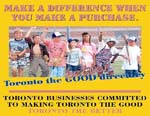(A supplemental resource for Worldwatch Paper 166, Purchasing Power: Harnessing Institutional Procurement for People and the Planet)
Around the world, businesses, governments, educational bodies and other large institutions are working for a better environment by making responsible purchasing decisions. With each network they form or buying decision they make, these groups are proving that environmentally friendly choices are not only good for the Earth, but are also sound business.
Here's a sampling of what some groups around the world are doing in the way of green purchasing:
Global
- More than 50 cities and other local governments in 20 countries now belong to the International Council for Local Environmental Initiatives' Buy-It-Green Network (www.iclei.org), which helps members exchange information and experiences, join forces, and make joint green purchases. (p. 44)
- More than 275 university presidents and chancellors in over 40 countries have signed on to the 1990 Talloires Declaration (www.ulsf.org/programs_talloires.html), a 10-point action plan that, among other things, encourages universities to establish policies and practices of resource conservation, recycling, waste reduction, and environmentally sound operations. (p. 46)
- In the hospitality industry, the International Hotels Environment Initiative, a global nonprofit network of more than 8,000 hotels in 11 countries, sponsors a web-based tool (www.benchmarkhotel.com) to help hotels improve their environmental performance (and save money) through purchases of items from energy-efficient lighting to environmentally preferable flooring materials, refrigerators, and minibars. (p. 46)
- The World Resources Institute is recruiting leading companies (www.thegreenpowergroup.org) to help meet its goal of developing corporate markets for 1,000 megawatts of new green power by 2010—enough capacity to power 750,000 American homes. (p.29)
- In 2001, more than a third of the cotton garments Nike produced contained a minimum of 3 percent certified organic cotton. In 2001, the company helped launch Organic Exchange (www.organicexchange.org), a network of 55 businesses that intends to significantly expand the use of organic cotton in manufacturing over the next 10 years. (p. 21)
Europe
- In 2002, the Swiss supermarket Migros (www.migros.ch) became the first European retailer to stop buying palm oil supplies from ecologically unsound sources in Malaysia and Indonesia. The company audits its suppliers for compliance with environmental criteria and labels products that “protect tropical forests.“ (p. 19)
- In Europe, 250 municipal leaders from 36 countries pledged in the Hannover Call (www.sustainable-cities.org/cevent.html) of 2000 to use their purchasing power “to direct development toward socially and environmentally sound solutions.“ (p. 25)
- Municipal purchasers in Dunkerque, France, have found that they now save about $.50 per ream (about 16 percent) by buying recycled paper. (p.17)
- Kolding, Denmark set an ambitious goal in 1998 of incorporating environmental considerations into 100 percent of its framework purchasing by 2002. By May 2001, roughly 70 percent of its purchasing requests had specified and integrated environmental demands, primarily in the areas of food, office equipment, cleaning products, IT equipment, and health care supplies. (p. 25)
Asia
- Japan's Green Purchasing Network (eco.goo.ne.jp/gpn/index.html) now boasts some 2,730 member organizations, including more than 2,100 businesses (among them Panasonic, Sony, Fuji, Xerox, Toyota, Honda, Canon, Nissan, and Mitsubishi); 360 local authorities in places like Tokyo, Osaka, Yokohama, Kobe, Sapporo, and Kyoto; and 270 consumer groups, co-ops, and other nongovernmental groups. (pp. 45-46)
- In 2001, Toyota (www.toyota.co.jp) switched some 1,400 office supply items and 300 computers and other equipment to green alternatives. It achieved 100 percent green purchasing in these areas in 2002. (p. 20)
United States
- The city of Santa Monica, California (pen.ci.santa-monica.ca.us), kicked off its green purchasing effort in 1994 with less-toxic cleaning products because a large body of knowledge about product alternatives already existed. Without doing too much additional research, buyers were able to replace traditional cleaners with less-toxic options in 15 of 17 product categories, saving 5 percent on annual costs and avoiding the purchase of 1.5 tons of hazardous materials per year.
- In 1999, Santa Monica, California, became the first U.S. city to buy 100 percent of its municipal power from renewable sources, including geothermal and wind energy.
- The state of Minnesota (www.moea.state.mn.us) now has some 110 different contracts for green products and services, including alternatively fueled vehicles, low-toxicity cleaning supplies, energy-efficient computers, and solvent-free paint.
- In 2002, the U.S. Archdiocese of Los Angeles received thousands of dollars in local rebates when the Cathedral of Our Lady of the Angels became the city's first religious edifice to install solar panels on its roof, generating enough energy to power both the building and more than 60 additional residences.
- In 2001, the city of Chicago and 48 suburbs pooled their jurisdictional resources to buy a larger block of electricity at a reduced rate, and will use the savings to meet at least 20 percent of group power needs with renewable sources by 2006.
- Kansas City and Jackson County in Missouri have agreed to pay a premium of 15 percent more for alternative fuels, cleaning products, and other products they consider environmentally preferable.
- In 2001, more than three-quarters of students at Connecticut College (www.connecticutcollege.edu) agreed to a voluntary $25 increase in their activity fees to fund the school's transition to renewable energy. By January 2003, the school was supplying 22 percent of its annual electricity consumption from new wind energy, the largest share purchased by any U.S. college or university. (p. 38)
- In November 2002, a group of 56 environmental groups across North America adopted a set of common environmental criteria for environmentally preferable paper and released detailed guidance to advise paper buyers about their choices. (www.conservatree.com/paper/Choose/commonvision.shtml) (p. 39)

